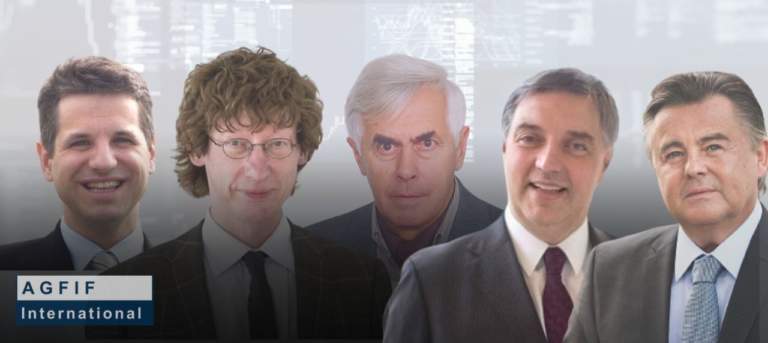The Investment Committee’s Core Team
The “Behavioural Finance” focus and the “Growth Focus” strategy are joined by additional, external economists.
Read more (Original Article in German)
AGFIF International is the first Swiss asset manager to bring the insights of behavioral finance to the client-advisory process and to asset-allocation decisions.

Read more (Original Article in German)

The key to investment success is to choose a well-researched and precisely defined asset allocation and to maintain that allocation over time,” explains AGFIF director Mojmir Hlinka. “This is extremely difficult given the unpredictability of market fluctuations, the recent increase in global instability, and the sheer volume of information—some of it valuable, some of it worthless or even misleading—available to us at all times. Behavioral finance allows us to understand our clients’ needs and goals irrespective of market circumstances, and helps our clients avoid the psychological pitfalls that often befall inexperienced investors. »Behavioral finance
AGFIF International is the first Swiss asset manager to offer its clients the benefits of comprehensive behavioral finance analysis, both during consultations and when determining asset allocations.
> Read more (Original Article in German)
Nobel laureate Daniel Kahnemann developed behavioral finance theory to explain why otherwise intelligent professional investors keep falling into these traps. Kahnemann found that such investors regularly adapt their risk preference to market conditions.
In other words, they become guided by emotions, both positive and negative. Accordingly, behavioral finance defines risk not as a fixed constant, but as a product of individual perception and emotional response. For AGFIF International, this means that no single investment strategy is best for individual investors. Only by working closely with our clients can we develop a portfolio that fits the specific risk profiles of each investor.
Nobel laureate
Daniel Kahnemann
(Image source: Wikipedia)
We work closely with Behavioral Finance Solutions (BhFS), a spinoff of the Universities of Zurich and St. Gallen. Founded in 2007, BhFS is led by one of our own advisors, noted economist Dr. Thorsten Hens.
“BhFS forms the bridge between the theory of behavioral finance and the practical application at AGFIF International,” says Dr. Hens. “Here we develop the fundamental insights that support rational decision-making by our clients in all market situations.”
Research Article: > Behavioural heterogeneity in the capital asset pricing model with an application to the low-beta anomaly.
Research Article: > Evolutionary Finance for Multi-Asset Investors.


We meet with each client in person to complete an extensive checklist that determines how they prefer to handle situations of increasing risk and/or uncertainty. On the basis of this knowledge, we create a bespoke portfolio of investments, weighted according to the client’s specific investment goals and risk-management style.
We are able to assess irrational market behavior quickly and accurately to make profitable investment decisions as a result.
At the same time, behavior finance informs our analysis of market behavior. By applying the techniques and insights of behavioral finance to the behavior of entire markets, we are able to assess irrational market behavior quickly and accurately, and to make confident, profitable investment decisions as a result.


F![]() inding reliable investment strategies in the midst of irrational market fluctuations.
inding reliable investment strategies in the midst of irrational market fluctuations.
![]() Strategies that minimize risks and identify opportunities.
Strategies that minimize risks and identify opportunities.
The evolutionary portfolio theory developed by AGFIF Advisor Dr. Thorsten Hens offers a powerful and empirically proven way to optimize wealth-building strategies regardless of market conditions. AGFIF draws on evolutionary portfolio theory when making investment decisions, and this work is supported by an extensive, precise, and ever-growing database system providing robust quantitative analysis.
While machines can easily perform purely quantitative procedures such as back tests and stress tests, human analysis has proven to be highly accurate, particularly on questions such as “What happens when many investors use the same strategy?” Human analysis is especially profitable when performing reflexivity tests and other measures of investor perception (e.g. “Who is on the other side of the market?”)
Finding reliable investment strategies in the midst of irrational market fluctuations is not a job for either human intuition or automated analysis. Both approaches are needed if we are to minimize risk and identify opportunities in a way appropriate to each investor.
This approach allows us to determine with some accuracy the extent to which investors will bear losses before changing their investment strategies. Such analysis is beyond the ability of even the most sophisticated of modern artificial intelligence to fully appreciate, and represents significant added value to AGFIF and its customers.